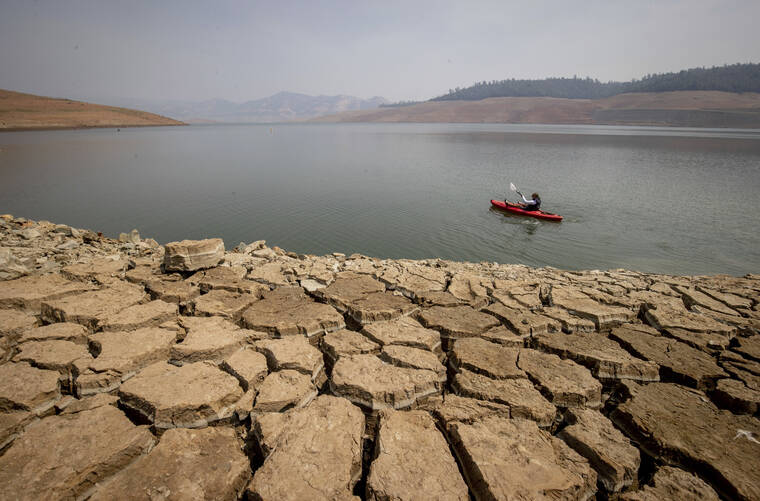SACRAMENTO, Calif. — California’s reservoirs are so dry from a historic drought that regulators warned Thursday it’s possible the state’s water agencies won’t get anything from them next year, a frightening possibility that could force mandatory restrictions for residents.
California has a system of giant lakes called reservoirs that store water during the state’s rainy and snowy winter months. Most of the water comes from snow that melts in the Sierra Nevada mountains and fills rivers and streams in the spring.
Regulators then release the water during the dry summer months for drinking, farming and environmental purposes, including keeping streams cold enough for endangered species of salmon to spawn.
This year, unusually hot, dry conditions caused nearly 80% of that water to either evaporate or be absorbed into the parched soil — part of a larger drought that has emptied reservoirs and led to cuts for farmers across the western United States. It caught sate officials by surprise as California now enters the rainy season with reservoirs at their lowest level ever.
“Nothing in our historic record suggested the possibility of essentially that snow disappearing into the soils and up into the atmosphere at the level that it did,” California Natural Resources Secretary Wade Crowfoot said. “These climate changes are coming fast and furious.”
California’s State Water Project — a complex system of dams, canals and reservoirs — helps provide drinking water to about 27 million people in the state. In December, state officials will announce how much water each district can expect to get next year.
Thursday, Department of Water Resources Director Karla Nemeth said the agency is preparing for what would be its first ever 0% allocation because of extraordinarily dry conditions.
“It’s a done deal, we’re sure that we will get a zero,” said Demetri Polyzos, manager of resource planning for the Metropolitan Water District of Southern California that provides water for about 19 million people. “These are uncharted territories, what we are seeing.”
The December announcement acts as an initial estimate. It could change later if things improve. That’s why this winter is so important. It’s impossible to predict with accuracy how much rain and snow California will get this winter. But if it’s anything like the last two winters, there will be even bigger problems.
California’s “water year” runs from Oct. 1 through Sept. 30. The 2021 year ends Thursday, and it was the second driest year on record, according to the Department of Water Resources. California had its warmest ever statewide monthly average temperatures in October, June and July, according to the National Oceanic and Atmospheric Administration’s National Centers for Environmental Information.
The 2021 water year began with reservoirs at 93% capacity. But California won’t have that cushion this year. The state’s reservoirs are at 60% of their historic average, state officials said.
The State Water Project provides about 30% of the Metropolitan Water District’s supplies, with the Colorado River supplying about 25%. The district also has some local supplies, including water it has in storage.
Last month, the agency declared a “water supply alert” and called for voluntary conservation. They’re offering rebates for things like more efficient shower heads and appliances and replacing grass lawns.
Despite the severity of the drought, Gov. Gavin Newsom has not declared a statewide emergency. Instead, he has declared emergencies in 50 of the state’s 58 counties, an approach his administration says is driven by lessons learned from the most recent drought when the state imposed restrictions statewide.
“(Water agencies) have explained to us that one size fits all mandates from Sacramento sometimes have unintended consequences,” Crowfoot said.
Still, California’s water supplies are in poor condition heading into the rainy season. In July, Newsom asked everyone to voluntarily reduce their water use by 15%. But in the first three weeks after that request, Californians reduced their water usage by just 1.8%, state officials said.
In a call with reporters on Thursday, Crowfoot said mandatory water restrictions “need to be on the table.” But he indicated those restrictions likely wouldn’t come until state officials have a better idea of how much water the state will get this winter.
“This winter will be determinative in terms of what additional actions we need to take on conservation,” Crowfoot said. “We’ll be watching.”


